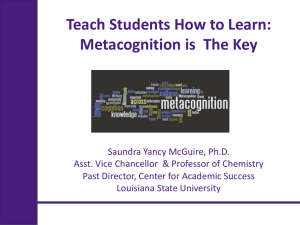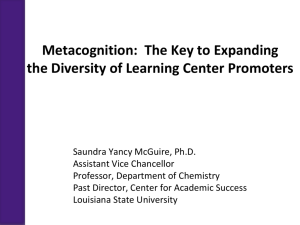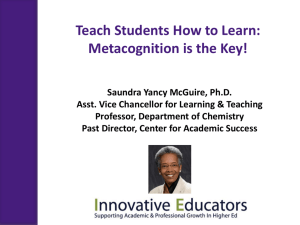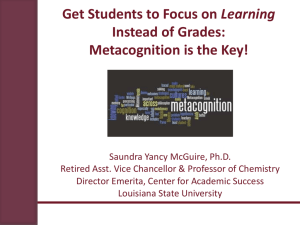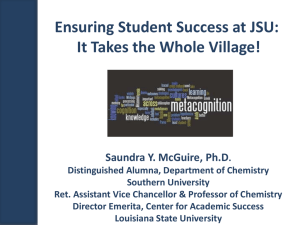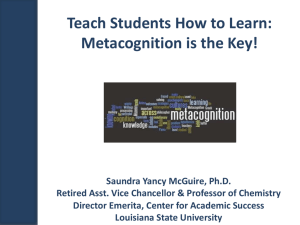Metacognition and Motivation - UNM-Taos
advertisement
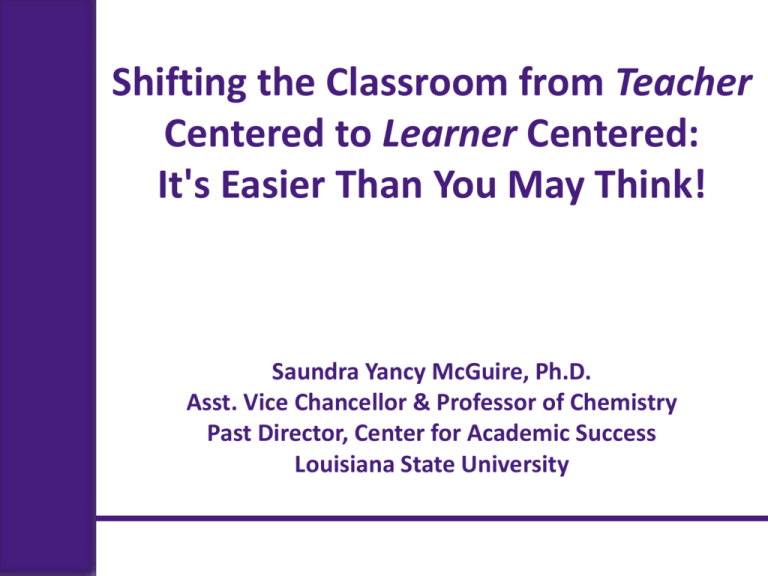
Shifting the Classroom from Teacher Centered to Learner Centered: It's Easier Than You May Think! Saundra Yancy McGuire, Ph.D. Asst. Vice Chancellor & Professor of Chemistry Past Director, Center for Academic Success Louisiana State University Paradigm Shift in Higher Education Teaching Centered Institutions Learning Centered Institutions Barr, R.B., and Tagg, J. "From Teaching to Learning - A New Paradigm for Undergraduate Education." Change, Nov-Dec. 1995, pp 13-25 Barriers to Making the Shift Most faculty don’t know how to move from teaching emphasis to learning emphasis Faculty professional development generally focuses on teaching strategies Most faculty are not prepared to teach students how to learn Most students do not understand that learning is a process How To Remove the Barriers Teach students how to learn Teach them metacognitive learning strategies Metacognition The ability to: think about one’s own thinking be consciously aware of oneself as a problem solver monitor, plan, and control one’s mental processing (e.g. “Am I understanding this material, or just memorizing it?”) accurately judge one’s level of learning Flavell, J. H. (1976). Metacognitive aspects of problem solving. In L. B. Resnick (Ed.), The nature of intelligence (pp.231-236). Hillsdale, NJ: Erlbaum Why don’t most students know how to learn or how to study? According to data from the entering class of 2011...* It wasn’t necessary in high school - 60.5% of 2011 (down from 63% in 2010) entering first year students spent less than six hours per week doing homework in 12th grade. - 49.7% of these students said they graduated from high school with an “A” average.* Students’ confidence level is high - 70.9 % believe their academic ability is above average or in the highest 10 percent among people their age *2011 Higher Education Research Institute Study Faculty Must Help Students Make the Transition to Learning Help students identify and close “the gap” current behavior current grades efficacious behavior desired grades Turn Students into Expert Learners: Teach Them Metacognitive Learning Strategies! The Story of Two Students Travis, junior psychology student 47, 52, 82, 86 B in course Dana, first year physics student 80, 54, 91, 97, 90 (final) A in course Travis, junior psychology student 47, 52, 82, 86 Dana, first year physics student 80, 54, 91, 97, 90 (final) Why the Fast and Dramatic Increase? It’s all about the strategies! Counting Vowels in 45 seconds How accurate are you? Count all the vowels in the words on the next slide. Dollar Bill Dice Tricycle Four-leaf Clover Hand Six-Pack Seven-Up Octopus Cat Lives Bowling Pins Football Team Dozen Eggs Unlucky Friday Valentine’s Day Quarter Hour How many words or phrases do you remember? Let’s look at the words again… What are they arranged according to? Dollar Bill Dice Tricycle Four-leaf Clover Hand Six-Pack Seven-Up Octopus Cat Lives Bowling Pins Football Team Dozen Eggs Unlucky Friday Valentine’s Day Quarter Hour NOW, how many words or phrases do you remember? What were two major differences between the two attempts? 1. We knew what the task was 2. We knew how the information was organized What we know about learning Active learning is more lasting than passive learning Thinking about thinking is important Metacognition The level at which learning occurs is important Bloom’s Taxonomy Bloom’s Taxonomy http://projects.coe.uga.edu/epltt/index.php?title=Bloom's_Taxonomy Making judgments based on criteria and standards through checking and critiquing. Carrying out or using a procedure through executing, or implementing. Retrieving, recognizing, and recalling relevant knowledge from long-term memory. Putting elements together to form a coherent or functional whole; reorganizing elements into a new pattern or structure through generating, planning, or producing. Breaking material into constituent parts, determining how the parts relate to one another and to an overall structure . Constructing meaning from oral, written, and graphic messages through interpreting, exemplifying, classifying, summarizing, inferring, comparing, and explaining. http://www.odu.edu/educ/llschult/blooms_taxonomy.htm When we teach students about Bloom’s Taxonomy… They GET it! How students answered At what level of Bloom’s did you have to operate to make A’s or B’s in high school? 1. 2. 3. 4. 5. 6. Knowledge Comprehension Application Analysis Synthesis Evaluation 35% 25% 21% 13% 1 2 3 4 3% 3% 5 6 How students answered At what level of Bloom’s do you think you’ll need to be to make an A in Chem 1201? 1. 2. 3. 4. 5. 6. Knowledge Comprehension Application Analysis Synthesis Evaluation 35% 23% 15% 14% 7% 6% 1 2 3 4 5 6 How do we teach students to move higher on Bloom’s Taxonomy? Teach them the Study Cycle* The Study Cycle 344 Reflect Review Reflect Preview Preview before class – Skim the chapter, note headings and boldface words, review summaries and chapter objectives, and come up with questions you’d like the lecture to answer for you. Attend Attend class – GO TO CLASS! Answer and ask questions and take meaningful notes. Review Review after class – As soon after class as possible, read notes, fill in gaps and note any questions. Study Assess Study – Repetition is the key. Ask questions such as ‘why’, ‘how’, and ‘what if’. Intense Study Sessions* - 3-5 short study sessions per day Weekend Review – Read notes and material from the week to make connections Assess your Learning – Periodically perform reality checks Am I using study methods that are effective? Do I understand the material enough to teach it to others? Intense Study Sessions Decide what you want to accomplish in your study session 1 Set a Goal 2 Study with Focus 30-50 min Interact with material- organize, concept map, summarize, process, re-read, fill-in notes, reflect, etc. 3 Reward Yourself 10-15 min Take a break– call a friend, play a short game, get a snack 4 Review 1-2 min 5 min Go over what you just studied Center for Academic Success Motivate Students to Engage in Learning Activities… Address the Bases of Intrinsic Motivation Why Is It Often Difficult to Motivate Students? Raffini, James P. (1995) 150 Ways to Improve Intrinsic Motivation. New York, NY: Allyn and Bacon. Bases of Intrinsic Motivation James Raffini, Allyn and Bacon, 1996 Strategies for Enhancing Student Autonomy Goal Setting Activity Self Report Card Strategies for Enhancing Competence Strategies for Enhancing Belonging and Relatedness Strategies for Enhancing Self-Esteem Strategies for Enhancing Involvement and Enjoyment Teacher’s Role in Student Motivation Eric Hobson, Albany College of Pharmacy When do teacher attitudes and course structure decrease motivation? Concluding Points about Motivation* How Do We Easily Shift the Classroom from Teacher Centered to Learner Centered? Teach Students HOW to Learn Motivate them to Engage Partner with the Learning Center 2004 National College Learning Center Association Frank L. Christ Outstanding Learning Center Award NCLCA Outstanding Learning Center 2012! Useful Websites www.caps.unm.edu www.cas.lsu.edu www.howtostudy.org www.vark-learn.com www.drearlbloch.com Searches on www.google.com Additional References Bruer, John T. , 2000. Schools For Thought: A Science of Learning in the Classroom. MIT Press. Bransford, J.D., Brown, A.L., Cocking, R.R. (Eds.), 2000. How people learn: Brain, Mind, Experience, and School. Washington, DC: National Academy Press. Cromley, Jennifer, 2000. Learning to Think, Learning to Learn: What the Science of Thinking and Learning Has to Offer Adult Education. Washington, DC: National Institute for Literacy. Ellis, David, 2006. Becoming a Master Student*. New York: HoughtonMifflin. Hoffman, Roald and Saundra Y. McGuire. (2010). Learning and Teaching Strategies. American Scientist , vol. 98, pp. 378-382. Nilson, Linda, 2004. Teaching at It’s Best: A Research-Based Resource for College Instructors. Bolton, MA: Anker Publishing Company. Pierce, William, 2004. Metacognition: Study Strategies, Monitoring, and Motivation. http://academic.pg.cc.md.us/~wpeirce/MCCCTR/metacognition.htm *Excellent student reference
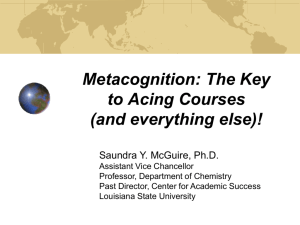

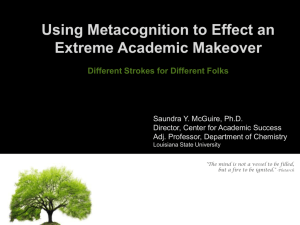
![File [ptx]](http://s3.studylib.net/store/data/009427298_1-8f707a5a5fa6e5d11883ac6bfef16f05-300x300.png)


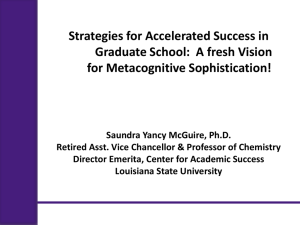


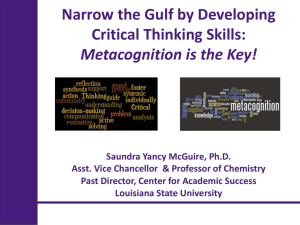

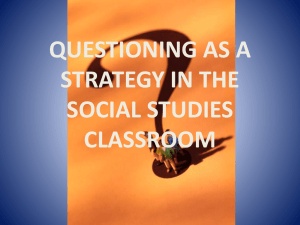
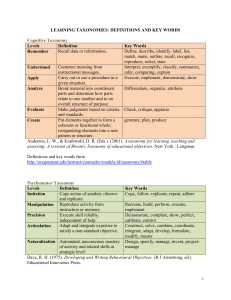
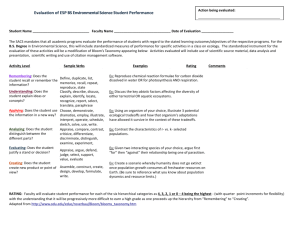
![File [ptx] - Kent State University](http://s3.studylib.net/store/data/009471766_1-c9863c0101d52ef451e19680e4b3f848-300x300.png)
